Does anyone miss the MacBook Pro Touch Bar so desperately that they need it back in almost any form? The answer would be yes if you’re talking to Eniac, a small company that’s just reinvented the not-quite-iconic Touch Bar as a Flexbar that can be used with the Mac, iPad, Android, and even your Windows PC.
Apple Introduced the Touch Bar on MacBook Pros in 2016. It was as close as a MacBook would ever come to having a touchscreen display. In practice, you often touched the Touch Bar, which sat embedded along the keyboard’s top edge, while looking at the touch-averse MacBook Pro screen. The Touch Bar was almost magically contextual, switching up display features depending on the app. The loss of function buttons and Power/TouchID button annoyed many hardcore MacBook Pro users, though. And Apple, perhaps sensing it had gone too far, killed the Touch Bar when it introduced its first Apple Silicon MacBook Pro laptops in 2022.
I lamented the loss and the Touch Bar’s “innate serendipity,” but I also understood the Touch Bar’s somewhat limited utility and recall how that OLED display went untouched for weeks at a time.
Few, not even me, saw a need for a new Touch Bar and certainly not one that sits outside the system.

As envisioned by Eniac and now on offer for $119 on Kickstarter, the new Touch Bar, called a Flexbar, is an aluminum bar featuring a 10-inch, 2K OLED display on one side. It looks every bit as adaptive as the original and even features haptic feedback. But it’s a thickish strip that has to sit on top of the space between your keyboard and laptop display.
Having it awkwardly lying there while also plugged into power via its USB-C port as you touch and swipe at it, seems inelegant at best and certainly not the kind of thing that would ever emerge from, say, Apple’s industrial design studio. At least there’s a magnetic stand to hold the Flexbar in place, but that just makes it stick up even more from the keyboard.
If someone is that desperate to add touch to a MacBook, wouldn’t they simply opt for an iPad? Similarly, many Windows 11 users enjoy touch-screen laptops; why do they need another touch-screen interface below that finger-friendly display?
What the engineers at Eniac might be missing here is the appeal of the original Touch Bar lay, at least in part, in that it was integrated into the MacBook Pro chassis. That made it subtle in the best way and allowed you to use it or casually ignore it. I don’t see any way of ignoring the thick, aluminum Flexbar.
Eniac obviously sees things differently. The portable design could be a bonus because it means one Flexbar can be paired with numerous systems. Plus, Eniac is clear about why they created the Flexbar. From the Kickstarter page:
“The discontinuation of the original Touch Bar didn’t mean the concept was flawed—it simply wasn’t taken far enough to reach its full. There’s something undeniable itself: the potential for a customizable, adaptive interface that could streamline workflows was immense.”
Flexbar does lean hard into customizability and macros; it appears just as functional and customizable as the original Touch Bar. But I still can’t see the MacBook Pro audience adopting it. It may find more fans among people who want to use it alongside Windows systems, iPads, and Android tablets. At $119 when it starts shipping in 2025, it may be cheap enough that people will say, “What the heck, I’ll give it ago.”
Even so, I would not call this a Touch Bar replacement as that’s kind of an insult to the original’s elegant design.
